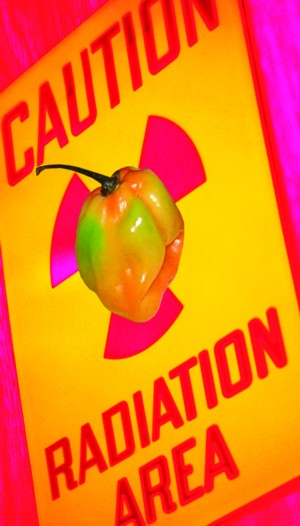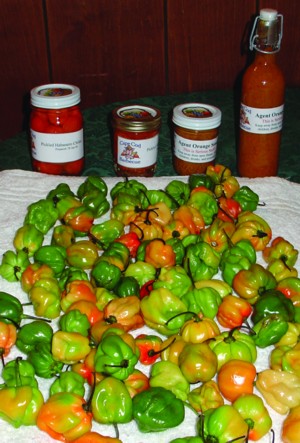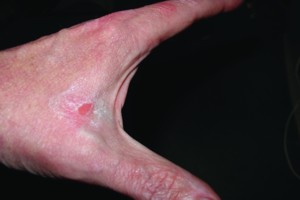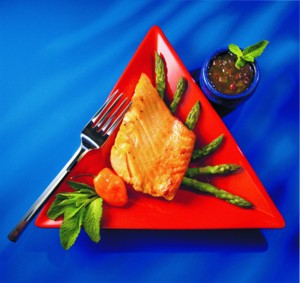By Mike Stines, Ph.B.

|
Recipes:Cranberry-Habanero Jelly
|
Well, the next trip came and went–no habaneros. A call to another green grocer a couple of towns away proved more productive. They’d be glad to pick up some habaneros from their wholesaler. The next afternoon, three pounds of bright orange habaneros were in my kitchen.

Another pound or so out of the way.

Even with a bevy of new recipes using the fiery fruit and the jelly, sauces and pickled habaneros, my freezer still has 10 vacuum-sealed bags of habaneros just waiting for another request from the Green Mountain State. Anyone need some habaneros?
Cranberry-Habanero Jelly
Although a bit of effort to prepare, this sweet and hot jelly goes well poured over a brick of cream cheese or just atop some crackers. It is also good when melted and used as a glaze for chicken or pork. Use caution to avoid breathing the vapors while processing or cooking the chiles. Be sure to wear food-safe gloves when handling habanero peppers and wash hands, knives, and cutting boards thoroughly, first in cold water and soap and then again with hot water and soap. Do not touch eyes, nose, mouth, or other sensitive body parts when handling the chiles. Chef’s note: If more heat is desired, add 5 to 10 finely minced Thai bird chiles to the habaneros and red bell peppers.
17 to 20 habanero peppers (about 1 cup diced)
1 1/2 to 2 large red bell peppers (about 2 cups diced)
1 1/2 cups white vinegar
1/2 cup whole cranberries, fresh or frozen
1/2 cup dried, sweetened cranberries (Craisins)
7 cups granulated sugar
1/3 cup fresh lemon juice
3 ounces liquid fruit pectin (1 pouch Certo)
Wearing food-safe gloves, stem, seed, and dice habanero peppers. Seed and dice the bell peppers. Process peppers in a food processor or blender until minced. Add the vinegar and continue processing until smooth.
Heat a 6 1/2-quart stockpot over medium-high heat. Add the pepper slurry, and the whole and dried cranberries. Cook, simmering and stirring often, until the whole cranberries burst, about 6 to 8 minutes. (Do not breathe the vapors!) Remove from heat. Use an immersion blender or food processor and puree until smooth.
Return stockpot to heat, add sugar and cook, stirring, until the sugar is dissolved. Add the lemon juice. Reduce heat to medium-low and simmer, stirring frequently, for 20 minutes. Increase heat to medium-high and bring the mixture to a rolling boil, add the pectin, and, while stirring constantly, cook for 1 minute. Remove from heat, ladle into sterilized containers, and process containers in a hot water bath for 10 minutes.
Yield: Makes 6 to 7 (8-ounce) jars
Heat Scale: Hot
Agent Orange Habanero Sauce
This is a seriously hot sauce; use it with caution. Keep away from pets, open flames, unsupervised children, drunks, and scoundrels. To preserve the unique fruity flavor of the chiles, the habaneros are not cooked. When handling habaneros use food-safe gloves and thoroughly wash knives, cutting boards, and utensils with cold soapy water and then hot soapy water. Chef’s note: This sauce has a shelf life longer than most nuclear waste but refrigerate after opening.
2 large carrots (1 1/2 cups) peeled & chopped)
1/2 medium red onion (1 cup) peeled & chopped)
1 1/2 cups white vinegar
1/2 cup water
6 cloves garlic (2 tablespoons minced)
1/4 cup fresh lime juice
1 tablespoon coarse kosher salt
1 teaspoon freshly ground black pepper
1/4 cup coarse grain or Creole mustard
12 to 14 habanero chiles, seeds and stems removed (3/4 cup minced)
Combine the carrots, onion, vinegar, water, garlic, lime juice, salt, pepper and mustard in a medium saucepan. Bring to a simmer over medium heat and cook, stirring occasionally, for 10 to 15 minutes or until the carrots are soft. Remove from heat.
Use an immersion blender or food processor to puree the mixture. Add the habaneros and continue to puree until smooth. Pour into sterilized jars or bottles and process in a hot water bath for 15 minutes.
Yield: About 2 3/4 cups
Heat Scale: Extremely Hot
Pickled Habaneros
It is important that the vinegar ratio not be altered to avoid any potential bacterial growth.
20 to 30 habanero chiles, stems removed
3 cups white vinegar
3 cups water
2 teaspoons coarse kosher salt
3 Mason-type (1-pint) canning jars, sterilized
Select habaneros that are fresh, firm, and free of blemishes. Wash in a mild bleach solution (1 teaspoon household bleach to 1 quart of warm water), rinse and allow to dry overnight.
Wearing food-safe gloves and using a sharp paring knife, cut two slits in the top of each chile. Tightly pack the chiles into the sterilized jars.
In a medium saucepan, combine the vinegar, water and salt. Bring to a boil and pour over the chiles. Seal the jars and store in a cool, dark place for at least 4 weeks before serving.
Yield: 3 jars
Heat Scale: Extremely hot
Cranberry-Habanero Glazed Pork Tenderloin
Pork is an inexpensive, flavorful and versatile meat that lends itself to a variety of preparations. This marinated and stuffed tenderloin is glazed with a spicy cranberry-habanero jelly and served with an apple compote, garlicky mashed potatoes and sugar snap peas. Tenderloins are packaged in pairs; this recipe uses both tenderloins and requires advance preparation.
1 whole pork tenderloin (two pieces, about 1 1/4-pound)
3/4 cup Cranberry-Habanero Jelly, melted
For the marinade:
3 cloves garlic, minced
1/2 cup chopped green onion
1 (12-ounce) bottle Woodchuck Amber hard cider
2 tablespoons Dijon mustard
1/2 teaspoon coarse kosher salt
1 teaspoon freshly ground black pepper
For the stuffing:
2 tablespoons olive oil
1 medium red onion, finely diced
1 rib celery, finely diced
2 Cortland or Macintosh apples, seeded and diced
2 cloves garlic, minced
2 cups day-old bread, cubed
3/4 cup Woodchuck Amber hard cider
1 tablespoon chopped fresh parsley
1 teaspoon chopped fresh thyme
2 teaspoon chopped fresh sage
Kosher salt and freshly ground black pepper
Remove any silverskin and extraneous fat from the tenderloins.
Prepare the marinade by combining all the ingredients in a medium mixing bowl. Place the tenderloins in a resealable food-grade bag, add the marinade and marinate the tenderloins, refrigerated, at least 4 hours or up to overnight.
Meanwhile, prepare the stuffing:
In a large skillet, heat the olive oil. Saute the onion and celery until soft, about 5 to 8 minutes. Add apples and garlic and cook 2 to 3 minutes. Add the hard cider and bread cubes and cook until moisture evaporates. Stir in herbs, salt and pepper. Adjust seasoning to taste. Cool completely. (Stuffing may be prepared one day ahead and held, covered and refrigerated.)
Remove the tenderloins from the marinade; discard marinade. Using paper towels, pat the tenderloins dry.
Brush the inside surface of the tenderloins with the cranberry-habanero jelly. Put a layer of stuffing atop one of the tenderloins. Place the second tenderloin, jelly side down, on top of the stuffing and tie the tenderloins together with butcher’s twine. Spoon any remaining stuffing in a buttered casserole dish and reserve. (If desired, the remaining stuffing could be cooked in a buttered casserole dish, covered, in a 350 degrees F. oven for 30 to 40 minutes.)
Preheat the oven to 425 degrees F.
Roast the stuffed tenderloins for 30 minutes. Brush melted jelly atop the stuffed tenderloins and continue cooking for another 20 to 25 minutes or to an internal temperature of 155 degrees F. Let the pork rest, tented with aluminum foil, for 5 to 10 minutes then bias-slice into 1/2-inch slices.
Yield: 6 servings
Heat Scale: Medium
(Chef’s note: The tenderloins could be cooked in a covered 350 degrees F. grill for about 45 to 60 minutes turning once.)

2 (6-ounce) swordfish fillets
Olive oil
Coarse kosher salt
Freshly ground black pepper
1/4 cup Agent Orange Sauce (see recipe)
2 cups mixed Field Greens or Mesclun Mix
Wasabi Vinaigrette (recipe follows)
Prepare the Wasabi Vinaigrette per recipe, reserve.
Place the fillets in a resealable food-grade bag and add 1/2 cup of the Wasabi Vinaigrette. Marinate, refrigerated, for 30 minutes.
Preheat the grill to medium-high and grease the grill grates with an oil-soaked folded paper towel. Season swordfish fillets with salt, and pepper. Place on the preheated grill and cook for 3 minutes; turn the fillets 90 degrees and cook another 2 minutes. Flip the fillets, brush with Agent Orange Sauce and cook, covered, for another 4 minutes or until the fillets just begin to turn opaque and start to flake. Remove from grill and keep warm.
Heat Scale: Medium
Wasabi Vinaigrette
1 teaspoon finely minced shallot
1 clove garlic, finely minced
1/2 teaspoon grated fresh ginger
1 1/2 teaspoons Wasabi powder (or more, to taste)
1 tablespoon Dijon mustard
1 teaspoon granulated sugar
1/4 cup rice wine vinegar
2/3 cup good quality olive oil
Coarse kosher salt, to taste
Freshly ground black pepper, to taste
Combine the shallot, garlic, ginger, Wasabi, mustard, sugar and vinegar in a bowl; whisk. Gradually whisk in the olive oil. Season with salt and freshly ground black pepper. Refrigerate at least 1 hour to allow the flavors to incorporate. Whisk well before use.
Yield: 1 cup
(Editor’s note: Mike Stines, Ph.B., is the author of Mastering Barbecue (Ten Speed Press, 2005). His e-mail is bbqChef@comcast.net.)




